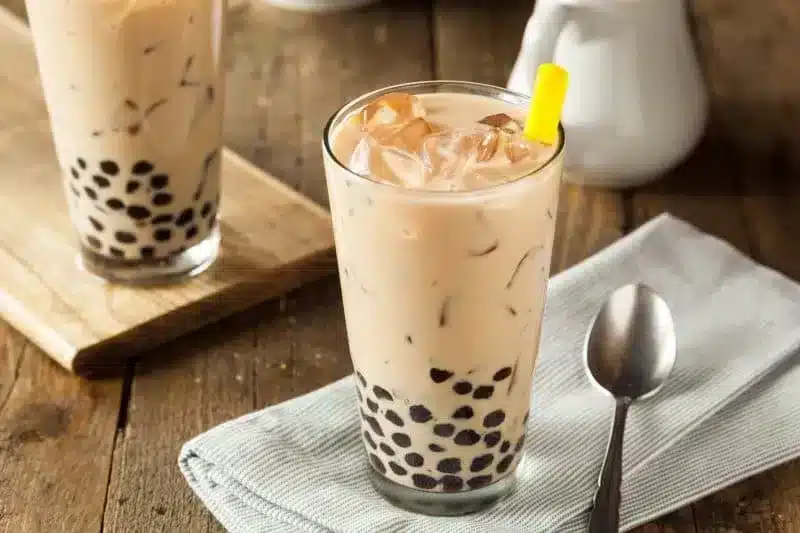What is Bubble Tea?

Introduction to Bubble Tea
Bubble tea, also known as ‘boba tea’ or ‘pearl milk tea’ originated in Taiwan in the 1980s and since then, it has become a global sensation. There is lots to know from its history, unique flavours you may never have heard of or how your bubble tea is made. In this blog, we will have a deep dive into everything there is to know about bubble tea. Hopefully, by the end of it you will leave with a greater appreciation of bubble tea and maybe even inspire you to try new flavours!
Bubble tea's origins can be traced back to Taiwan, a country renowned for its vibrant street food culture. In the early 1980s, it was said that a teahouse started serving Chinese tea cold and not too long after this, Ms Lin Hsiu Hui added her boss’ favourite Taiwanese dessert fen yuan into his milk tea and the rest is history.
The blend of flavours and textures in this iconic beverage makes it seem as though it was carefully experimentation but it is astonishing to think it was just a spontaneous moment of creativity that led to this global phenomenon. The drink’s signature is the tapioca pearls or ‘boba’ and the name ‘bubble tea’ comes from the frothy bubbles that form when the tea is shaken or blended.
Bubble Tea Ingredients
The heart of bubble tea lies in its ingredients. Here are a few of the main ingredients used.
1. Tea: Traditionally, black tea or green tea forms the base of bubble tea. The choice of tea provides a fundamental depth of flavour that serves as the canvas for the various creative combinations and toppings that make bubble tea intriguing. Black tea is favoured for its robust and slightly bitter taste, making it pair well with sweet flavourings. On the other hand, green tea offers a lighter and more grassiness, allowing for a refreshing twist.
2. To get the milk flavour, creamer is used as an easier way of enhancing the drink’s creaminess and texture.
3. Tapioca balls and Toppings: Bubble tea is known for the chewy tapioca pearls that come in it; however, there are many more toppings to explore and diversify your experience.
4. Fructose and other syrups: Fructose’s role is to sweeten the drink and the flavoured syrup is to add any desired flavours such as brown sugar, hazelnut or honey.
How Bubble Tea is Made
1. Brew the tea: Begin by brewing your choice of tea and pouring it into the cocktail shaker
2. Cook tapioca pearls: Boil the tapioca pearls and strain them. Add hazelnut syrup to give them a sweet and aromatic smell and stir. You can scoop them and place it into the cup
3. Sweeten it up: Add fructose or syrup to the tea with your desired amount.
4. Add the creamer: Pour the creamer in and mix thoroughly with the tea.
5. Add ice and shake for 3-5 seconds
6. Assemble the bubble tea: Pour the drink in the cocktail shaker into the cup with tapioca balls and seal with a sealing machine or lid. Pop in a straw and your drink is ready to drink!
Exploring Bubble Tea Flavours
There is such a wide variety of bubble tea beverages available, with regional preferences varying from place to place. In the UK, popping boba is popular as well as the flavours such as taro milk tea and mango milk tea whereas in Taiwan, original milk tea is the popular go-to drink. Due to its popularity, ease of setting and profitability, more bubble tea shops have opened up, as well as other types of businesses like restaurants, cafes and even theme parks which have started to incorporate bubble tea into their menu.
The basic teas used in bubble tea are black tea and green tea. Black tea provides a deep, robust flavour and is used in the original milk tea and Green tea offers a lighter and refreshing option which is used for fruit teas.
Beyond the classics, bubble tea has expanded its repertoire to include a myriad of popular variations. Among these, you will find matcha with its unique blend of earthy and sweet notes. Taro, a starchy and nutty-flavoured root, offers a delightful twist with its creamy and naturally rich taste. Additionally, Thai milk tea stands out, characterised by its distinct orange hue and aromatic spices.
Another key contributor to the array of flavours in bubble tea, including fruity, nutty, and honey-infused options, is the use of syrups. These syrups impart a delightful and sugary burst of flavour to your beverage. They effortlessly blend with the drink, delivering a subtle but pronounced note of the desired flavour.
Toppings and Add-ons
The most popular topping is the tapioca pearls and in the UK, the popping boba is also very popular. Other toppings that are common are jelly and aloe vera. More unique ones that may make an appearance once in a while during certain seasons or holidays are cream foams, white tapioca, pudding, red beans or grass jelly.
Frequently Asked Questions about Bubble Tea:
Is Bubble Tea Healthy?
Yes, bubble tea can be healthy. In this article, we explore the 3 health benefits of bubble tea.
Is bubble tea suitable for vegetarians or vegans?
The good news is it's easy to make sure your bubble tea is vegan.
Is bubble tea Halal?
The short answer is yes. The majority of bubble tea products are halal. The main concern with bubble tea is generally the Tapioca balls or pearls or the popping bobas which resemble other Gelatin products, such as sweets and jelly. These balls are made from agar or alginate (a seaweed extract), both Halal.
If you are interested in exploring bubble tea, contact Taipec, a leading bubble tea supplier in the UK, for more information.
